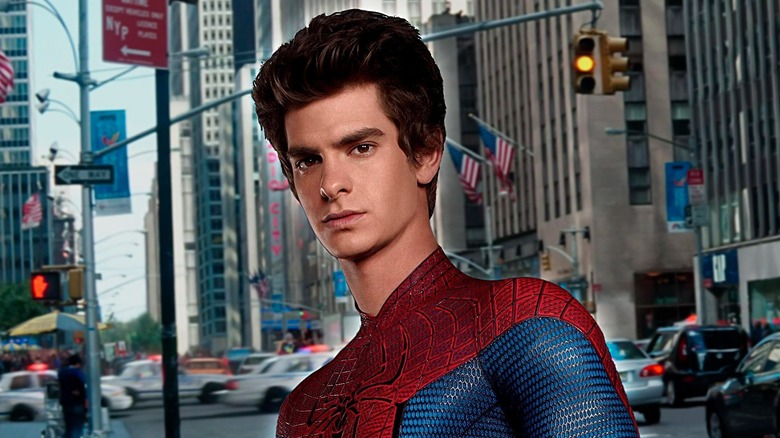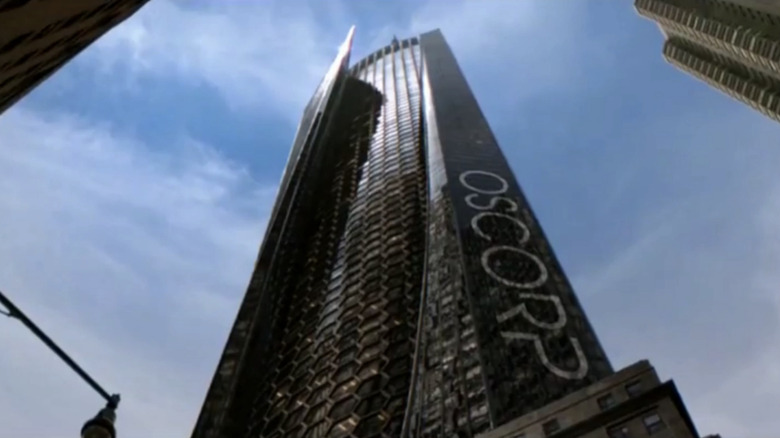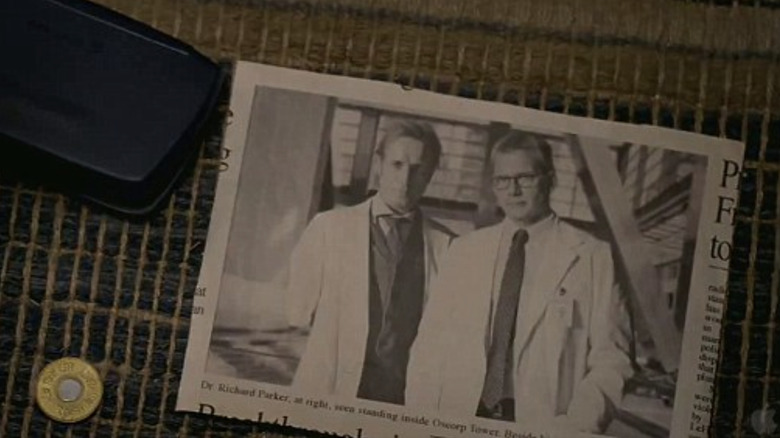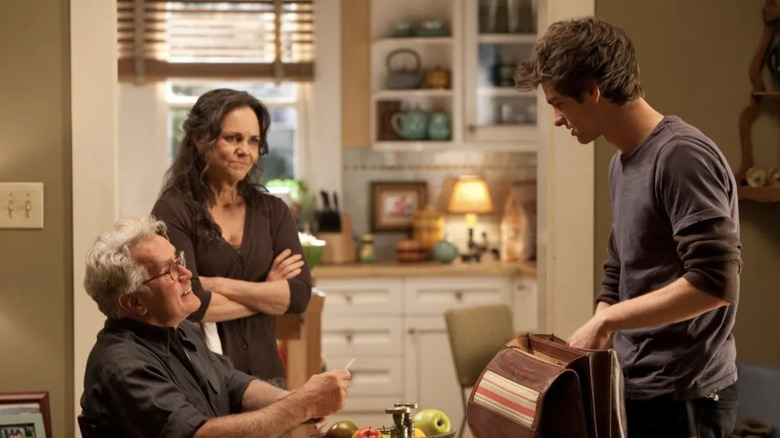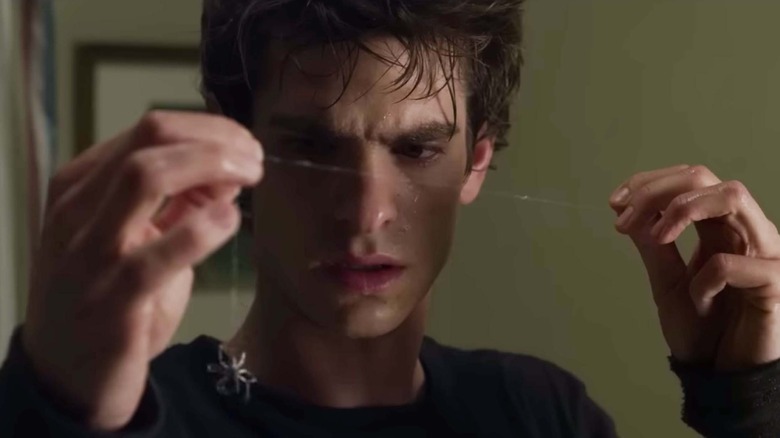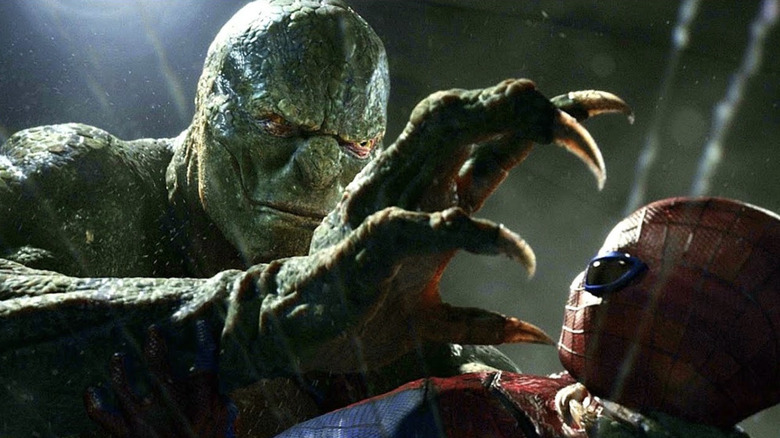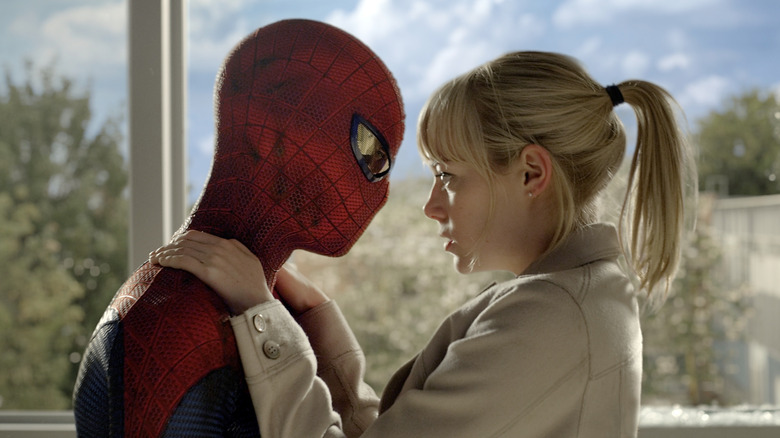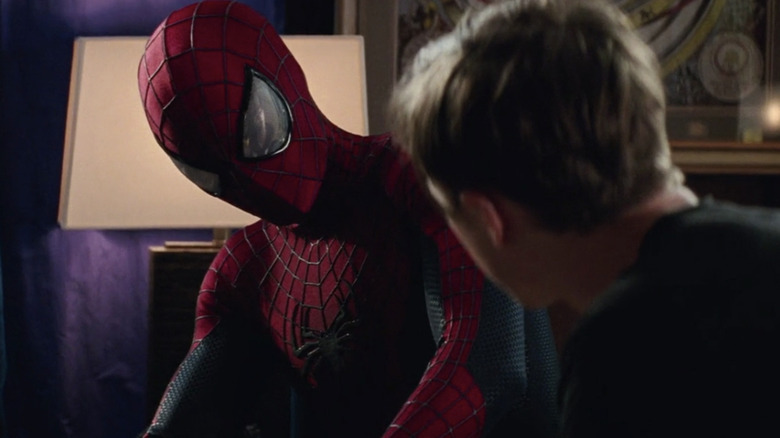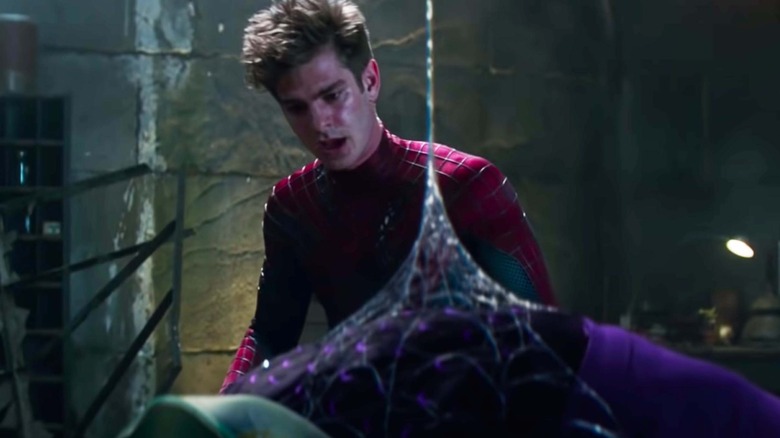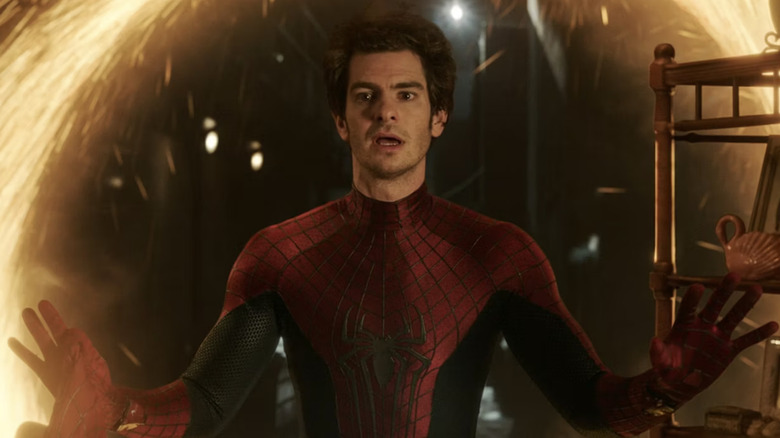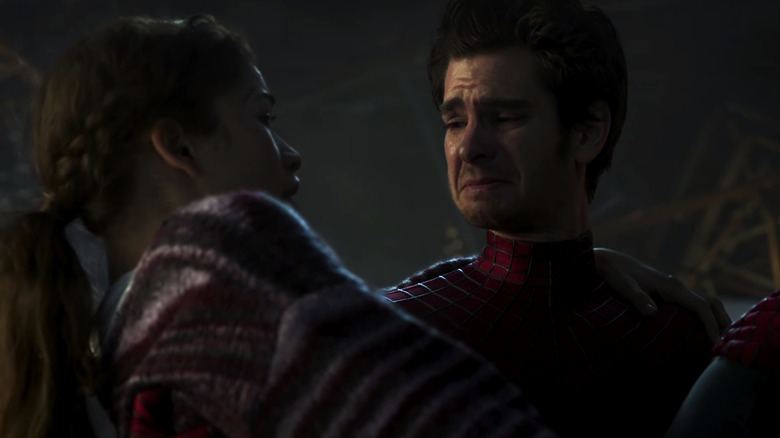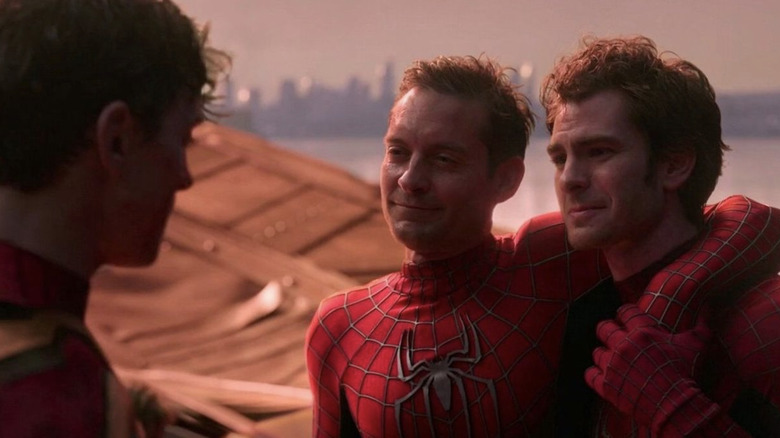Andrew Garfield's Amazing Spider-Man Story Finally Explained
For years, many fans were critical of the second live-action Spider-Man to swing into theaters in the 21st century. That's right – Andrew Garfield's Spider-Man wasn't nearly as beloved a decade ago as he is now. A common criticism at the time was that he arrived in theaters too early for a reboot of the character. For reference, "Spider-Man 3" (the final in Sam Raimi's original trilogy) premiered in 2007, while "The Amazing Spider-Man" came out back in 2012. That's less time than there was between Christian Bale and Ben Affleck's respective Batmans.
But whether you loved or hated him at first, Garfield's "Amazing Spider-Man" became a cult favorite over time, with many even hoping that Marvel Studios would find a way to insert him into the Marvel Cinematic Universe. Ultimately, they decided to reboot the character entirely, and the original plans for a multi-part "Amazing Spider-Man" saga were scrapped. Some movies, such as "Venom," eventually happened, but Garfield's Spidey was pushed aside in favor of the newer and younger model.
But with his return in "Spider-Man: No Way Home," the Amazing Spider-Man has become a fan-favorite, with many now hoping that we'll see an "Amazing Spider-Man 3" after all. Given the popularity of the character, nothing is impossible, but while we patiently wait to see more of this Spidey variant, let's reflect on the Amazing Spider-Man's entire story and uncover the secrets of Andrew Garfield's Peter Parker.
It all begins with Oscorp
Evil corporations are one of the most consistent tropes in modern media (which is ironic, given that most modern media is produced by evil corporations) and just about every superhero has gone up against one. So, it's no wonder that "The Amazing Spider-Man" movies — taking plenty of cues from the "Ultimate Spider-Man" comic books, which highlight this same idea — introduce Oscorp Industries as this series' very own evil corporation. Headed by Norman Osborn (Chris Cooper), Oscorp researches potential cures for degenerative diseases like the one he inherited.
Richard Parker (Campbell Scott) and Curt Connors (Rhys Ifans) soon begin experimenting with animal and insect DNA in order to find a miracle cure and help save the world. Missing an arm himself, Connors hopes the application will eventually mutate into regrowing detached limbs, and soon the project — labeled Double Zero — is successful. After Richard uses his own genetic sample as a base, combined with that of spider DNA, the results prove significant. This is where the Amazing Spider-Man's powers ultimately stem from — this genetics research.
But just as a teenage Peter Parker stumbles onto his father's research and accidentally gives himself superpowers, so too does Norman's son Harry Osborn (Dane DeHaan). Harry contracts the same genetic disease as his father, as well as his desperation. Turns out, that old saying about sins of the father affecting their sons holds true in this story.
The Parkers die protecting their son
Despite the humanitarian aspirations of his research, Richard Parker soon discovers that Norman plans to use the Double Zero project as the basis for military contracts and weapons once he finishes curing himself. Not wishing to be responsible for a new form of superpowered warfare, Richard erases all of the data from Oscorp's file system and attempts to completely destroy his research (which he compiles on an abandoned railway car named Roosevelt Station that he builds within New York City's subway system). Unfortunately, Richard isn't able to destroy the spiders.
In the hardest choice Richard ever makes, he and his wife Mary (Embeth Davidtz) decide the best thing to do to keep their family safe is to leave their old lives behind. Placing their son Peter with Richard's brother Ben (Martin Sheen) and his wife May (Sally Field), the Parkers leave the country until they know it's safe to return. Tragically, their seemingly clear getaway is foiled by Norman's men who attempt to assassinate the Parkers in their private plane. In all the commotion, Richard fights back but to no avail as the plane crashes, resulting in their deaths.
That is unless the alternate ending to "The Amazing Spider-Man 2" — revealing that Richard is alive as he reunites with Peter — is to be believed. But, since the "Amazing" story never continued, Richard Parker is likely still six feet under.
Peter was raised by his aunt and uncle
After his parents leave him behind, Peter is raised by his aunt and uncle. It's the usual Spider-Man story that every, well, almost every version of Spider-Man has in common. This time around, Uncle Ben and Aunt May have raised a fairly sarcastic, uber-intelligent, and athletic-ish (he occasionally rides a skateboard) Peter Parker who spends the entire first "Amazing Spider-Man" movie in high school. But despite Ben and May being the best surrogate parents he could ask for, Peter always seeks the truth about his parents' disappearance.
Their departure is strange, sudden, and leaves Peter wondering what could have been so bad that they had to leave. So, when he finds his father's old briefcase, complete with some new information about his father's mysterious past, Peter seeks out none other than Curt Connors. We'll get to the results of that more in a moment, but there's one other thing that Uncle Ben imparts to Peter on behalf of his father — one thing that every Spider-Man aficionado knows all too well.
While "The Amazing Spider-Man" doesn't include the famous "with great power, there must also come great responsibility" line, Ben gives Peter the speech in his own way, and the message remains the same ... if only Peter listened.
A spider bite changes everything
Hoping to learn more about his father's work, Peter breaks into Oscorp Tower. It's here that Peter discovers the world he could have grown up in, taking a keen interest in the life he might've had if his folks hadn't abandoned him. Also catching his eye is none other than Gwen Stacy (Emma Stone), his classmate who moonlights as Connor's assistant. But not even Gwen can keep Peter from his goal, and he soon finds himself in the room full of genetically mutated spiders, one of which finds its way into Peter's shirt and eventually bites him.
This bite is the catalyst for Peter's super-heroic abilities, and after succumbing to the genetic revamp, he can soon crawl on walls, sense danger, lift nearly 10 times his own body weight (if not more), and has the stamina of a real spider. The only thing this version of the character cannot do is spin webs of his own (that power is reserved for Tobey Maguire's version). Thankfully, it isn't long before Peter can develop webs via web-shooters he builds all by himself.
But Peter's life takes an even more dramatic turn after a run-in with a terrible cashier. After letting a robber get away, the same man immediately kills his Uncle Ben. Unable to save his uncle, Peter decides to take vengeance into his own hands.
Spiders and lizards don't mix
Failing to catch the man responsible for his uncle's murder, Peter decides to be responsible with his new abilities. As Spider-Man, Peter starts to do the job of the NYPD, stepping often on the toes of Captain George Stacy (Denis Leary), who just so happens to be the father of his high school crush. But Captain Stacy isn't his only issue. After Peter befriends and helps Connors with his algorithm in cross-species genetics, the mad scientist experiments with his new formula on himself. While everything starts off well and good with his arm growing back as good as new, he soon mutates into a humanoid Lizard.
In a fit of rage, the Lizard attacks folks on the Williamsburg Bridge, though thankfully, the Amazing Spider-Man arrives just in time to save him and a bunch of other citizens from being tossed overboard. The Lizard escapes before Spidey can do anything, though, and soon comes up with a plot to turn the whole city into mutant lizard people like himself, with Oscorp Tower labeled ground zero. Although Spider-Man defeats Connors, who transforms back into his normal self, it's at a serious cost. Captain Stacy dies helping Spider-Man and forces Peter to promise to keep Gwen away from his super-heroics.
Peter Parker and Gwen Stacy
If you know anything about Spider-Man, it's that nothing can keep him from the woman that he loves. (Not permanently, anyway.) Over the course of the first "Amazing Spider-Man," Peter and Gwen fall in love and she soon learns about his double life as a superhero. In fact, Gwen helps Peter unravel the Lizard's diabolical plan by creating an antidote to Connor's formula. Once Peter administers it, the city is saved, and Connors reverts to normal. But despite Gwen losing her father and his dying wish for Peter to not date her, it seems like nothing can keep these two apart.
Between "The Amazing Spider-Man" and "The Amazing Spider-Man 2," two years have passed. During that time, Peter and Gwen remain a couple as Peter continues to fight crime as Spider-Man (with a brand-new suit more akin to the original comics) but the two split apart after Peter, haunted by the ghost of Gwen's father, breaks things off just after their high school graduation. To make matters more complicated, Gwen considers moving to England if she gets a scholarship at Oxford University, which means that she might not be living in New York much longer.
Despite their relationship status, Peter still follows Gwen every day and watches out for her from afar, unable to completely let her go. What some viewers could find creepy, others might consider actually sort of romantic, especially since Peter and Gwen end up patching things up before she leaves. If only that were the end of it.
The rise of Electro
While out on patrol as Spider-Man, Peter saves a man named Max Dillon (Jamie Foxx), who just so happens to be an electrical engineer at none other than, you guessed it, Oscorp. After this encounter, Max becomes obsessed with Spidey, believing him to be his only friend in all of New York City. The problem is that Spider-Man only calls him by name because he reads his nametag and shares some inspirational words with Max out of kindness, not personal friendship. When Max is accidentally electrocuted at Oscorp by a cocktail of electric eels and electrical wire, which gives him superhuman abilities, guess who he immediately wants to track down?
In battling Max (now calling himself Electro), Spidey doesn't see the mild-mannered Oscorp employee he saved in the streets — he sees a dangerous threat to the city. Although that may have been the wrong way to play things, Spidey's intuition isn't far off. Electro eventually learns to control his powers and becomes more dangerous (not to mention powerful) than almost any of the previous live-action Spider-Man villains, but that part comes later. In the meantime, Peter has other concerns on his mind that have nothing to do with Max — namely, the return of his childhood best friend Harry Osborn, after the death of his father, Norman.
Peter's ghosts catch up with him
When Harry returns, Peter isn't quite sure what to think. The two of them haven't seen each other in years, so after Norman's passing (and the revelation that Harry has the same degenerative disease as his dad), Harry returns to New York to continue his father's work as acting CEO of Oscorp Industries. As they catch up, Peter is happy to have his friend back, but their reunion is ultimately short-lived. Harry isn't the only part of Peter's past that returns in "The Amazing Spider-Man 2."
It's in this film that Peter learns the truth behind his parent's deaths after accidentally discovering the Roosevelt Station that houses his father's life's work. Peter soon learns that it's the Parker genetic code that works exclusively with the genetically engineered super spiders, which is the reason he was granted superhuman abilities. In this world, there can only be one Spider-Man since Peter's genetic code is the key to unlocking the Double Zero genetic formula housed within the experimental spiders.
So when Harry asks Peter to get him a vial of Spider-Man's blood, and Spidey refuses due to ethical and medical concerns, Harry loses it. Like Connors before him, he experiments on himself with a select brand of Oscorp formula and becomes ... the Green Goblin.
Gwen's death changes things
After Harry frees Electro from lock-up in hopes of taking down Spider-Man to use his blood as a miracle cure, the two baddies raise havoc across New York with Electro targeting the city's power supply. There, Spider-Man battles the almost god-like supervillain, who nearly kills our web-swinging hero before Gwen arrives in the nick of time to save him. Shortly before these events, Peter promises to move with Gwen to England where the two of them hope to live the life they always dreamed before he jumps back into action to fix the mess he inadvertently created.
With Gwen's help, Spider-Man defeats Electro, but an enraged Green Goblin arrives just in time to drop Gwen from the sky. Though Peter catches her, he's unable to keep her safe while he battles Harry, and Gwen falls to her death. Peter does everything he can to save her, but it isn't enough, and after defeating Harry, Peter holds Gwen's lifeless body tight in his arms. The ghost of Captain Stacy predicted Gwen's fate, and now Peter is left to pick up the pieces. As a result, he leaves Spider-Man behind ... at least for a while.
Months go by before a pep-talk from Aunt May (who totally knows Peter is Spider-Man) and a rewatch of Gwen's graduation speech encourages Spider-Man to get back out there and save lives, namely from a man in a mechanized Rhino suit (Paul Giamatti).
Peter finds his way to another universe
Almost a decade passed before we saw or heard from Andrew Garfield's Amazing Spider-Man again. Though we don't know exactly how much time has passed in movie time, we know that years of our time occurred between 2014's "The Amazing Spider-Man 2" and 2021's "Spider-Man: No Way Home." In "No Way Home," Peter makes his way through a portal between universes after the MCU's Peter Parker (Tom Holland) breaks Doctor Strange's (Benedict Cumberbatch) spell, which accidentally pulls villains from other universes who know Spider-Man's secret identity into his world.
After wandering around the MCU's New York for a while, Peter eventually meets up with MJ (Zendaya), Ned Leeds (Jacob Batalon), and an older alternate version of himself (Tobey Maguire from the original Sam Raimi "Spider-Man" film trilogy) before encountering the younger MCU Spider-Man just after his Aunt May (Marisa Tomei) is killed. Peter and his older counterpart share their past experiences in losing loved ones, and eventually echo the MCU's Aunt May's final words, "With great power comes great responsibility."
With that, the three Spider-Men decide that the best way to help the villains from the other worlds — including Electro and the Lizard from "The Amazing Spider-Man" movies, as well as Green Goblin (Willem Dafoe), Doc Ock (Alfred Molina), and Sandman (Thomas Haden Church) from the original "Spider-Man" trilogy — is to work together. So, using their scientific minds, the Spider-Men develop cures for all five villains.
Peter makes up for his past mistakes
One of the most memorable moments in "Spider-Man: No Way Home" occurs when the Green Goblin blows up the scaffolding on the Statue of Liberty, knocking MJ off her balance and sending her plummeting to the ground. Echoing Gwen's death in "The Amazing Spider-Man 2" (not to mention calling back to the very first "Spider-Man" from 2002), Peter watches helplessly as the MCU Peter is unable to save his true love. So, Amazing Peter does what any Spider-Man would do and tries again.
Having likely played Gwen's death through his mind countless times, Spidey is able to do here what he wasn't able to years ago, and he saves MJ from the brink of death. After not being able to save Gwen from the Green Goblin's schemes, Peter is finally able to receive that emotional catharsis he's been searching for all these years (while also providing some catharsis for fans who were traumatized by Gwen's original death in "Amazing Spider-Man" #121 from 1973). He might not have been able to live the life he always dreamed of with the woman he loved, but he was sure to save the possibility of that dream for a younger version of himself.
But that isn't the only wrong that the Amazing Spider-Man rights in "No Way Home." He is also able to cure the Lizard for the second time on screen and manages to do the same for Electro as well, and reminds the cured Max Dillon that he was never a nobody.
Could the Amazing Spider-Man return?
"Spider-Man: No Way Home" ends with both Andrew Garfield's Amazing Spider-Man and the original Tobey Maguire Spider-Man returning to their respective worlds, but that doesn't mean that they can't return again in the future. Especially since it seems like Marvel Studios is interested in revisiting many of these stories again in the future, possibly sooner than we think.
Projects like "Loki" and "Doctor Strange in the Multiverse of Madness" prove that more timelines and universes exist outside of the MCU, and Marvel is building their interconnected universe even bigger than ever. Even Sony's work with the "Spider-Verse" movies reminds us that there's a bigger Spider-Man-centric story out there. And let's not forget about Sony's Spider-Man Universe, which many have speculated might secretly be the home universe of Garfield's Amazing Spider-Man.
That's not to mention the ongoing rumors that Andrew Garfield and Tobey Maguire may return in "Avengers: Secret Wars," which aims to be a multiversal epic even bigger than "Avengers: Endgame." But whatever happens, we know that the Amazing Spider-Man is still out there living out the "great responsibility" he has undertaken.
